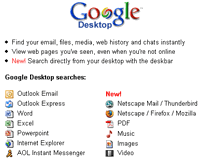 Google has taken its free desktop search tool out of beta and unveiled a finalised version capable of searching the full text of pdf files and the metadata of multimedia files.
Google has taken its free desktop search tool out of beta and unveiled a finalised version capable of searching the full text of pdf files and the metadata of multimedia files.
The beta version could only index the names of such files, but the all-singing final application can index the entire content, including useful data such as song and artist names in music files.
Google product manager Nikhil Bhatla explains: “We’ve taken the product out of beta because now we have all the file types and features that were high on the list of user requests”.
Bhatla also explained that Google hoped that more people would be encouraged to download and install the product now that it’s no longer described as a beta app.
Google introduced its desktop product in October of last year, promptly followed by big search engine providers such as Microsoft, Ask Jeeves, Yahoo and AOL who are all keen to grab a slice of the desktop search market.
Desktop searches are one of the key battlegrounds for search engine companies, who hope that users installing desktop apps will extend their loyalty to the tool maker’s Internet search engine – and thus increase profits from the lucrative, keyword-related online ads market.
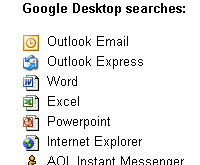 Other improvements in the Google desktop tool are support for Mozilla’s Firefox and Thunderbird applications and AOL’s Netscape browser and e-mail application (previously, the product only supported Internet Explorer and Outlook/Outlook Express).
Other improvements in the Google desktop tool are support for Mozilla’s Firefox and Thunderbird applications and AOL’s Netscape browser and e-mail application (previously, the product only supported Internet Explorer and Outlook/Outlook Express).
The program can now index a veritable army of multimedia files including MP3, WMA, WAV, JPG, GIF, PNG, BMP, AVI, MPG and WMV.
There’s also a growing range of plug-ins available, letting users index content from a wide variety of sources including instant messaging (IM) conversations from Cerulean Studios’ popular Trillian Pro IM application, mIRC, music metadata files acquired from Apple’s iTunes music store and OpenOffice.org and StarOffice documents.
Interestingly, Google are also looking to a third-party developer to create a speech-to-text plug-in to allow the product to transcribe the content of audio and video files and make it searchable – increasing the indexing capabilities of those files beyond metadata.
![]() Although this desktop search tool is designed for use by consumers, Google have their eye on the workplace too, with the program able to recognise Microsoft group policy parameters on a PC.
Although this desktop search tool is designed for use by consumers, Google have their eye on the workplace too, with the program able to recognise Microsoft group policy parameters on a PC.
 It’s been delayed more times than the 8:25 from East Grinstead on a leaf-strewn morning, but Fossil has finally released its super geeky Fossil Wrist PDA Palm Powered watch.
It’s been delayed more times than the 8:25 from East Grinstead on a leaf-strewn morning, but Fossil has finally released its super geeky Fossil Wrist PDA Palm Powered watch.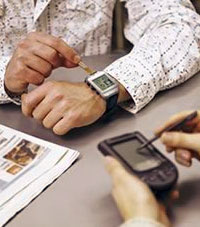 The watch itself is made of stainless steel, with a teensy weensy fold out stylus cunningly secreted in the strap buckle. Fossil have managed to fit in a USB socket and infra red port, along with three buttons and a rocker switch for onscreen navigation.
The watch itself is made of stainless steel, with a teensy weensy fold out stylus cunningly secreted in the strap buckle. Fossil have managed to fit in a USB socket and infra red port, along with three buttons and a rocker switch for onscreen navigation.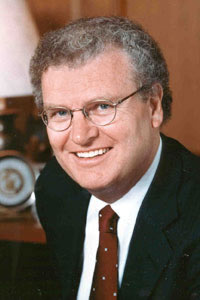 In an extraordinary move, Sony has named the Welsh-born head of its US operations, Sir Howard Stringer, as chairman and chief executive – a rare move for a major Japanese company to give its top post to a foreigner.
In an extraordinary move, Sony has named the Welsh-born head of its US operations, Sir Howard Stringer, as chairman and chief executive – a rare move for a major Japanese company to give its top post to a foreigner. Digital television continued to grow in Europe last year, according to a Strategy Analytics’ survey of more than 70 digital television operators across 16 countries.
Digital television continued to grow in Europe last year, according to a Strategy Analytics’ survey of more than 70 digital television operators across 16 countries. The Advertising Standards Authority (ASA) has dished out a mixed ruling on a complaint about claims made by Bulldog (owned by Cable & Wireless) for its 4Mbps broadband service.
The Advertising Standards Authority (ASA) has dished out a mixed ruling on a complaint about claims made by Bulldog (owned by Cable & Wireless) for its 4Mbps broadband service. Bulldog seems to have become unstuck by the success of their own advertising, with customers instantly clambering for a piece of the ‘ultimate broadband experience’.
Bulldog seems to have become unstuck by the success of their own advertising, with customers instantly clambering for a piece of the ‘ultimate broadband experience’. After a shaky start, the 3G bandwagon is finally starting to roll with 20 million 3G phones sold last year and shedloads of new funky, feature-packed phones on the way.
After a shaky start, the 3G bandwagon is finally starting to roll with 20 million 3G phones sold last year and shedloads of new funky, feature-packed phones on the way. “We’re very much at the foothills regarding content on mobiles,” says Price. “Now we’re going to have to be a bit more experimental and different. The network owners are looking for something that pushes the boundaries a bit more and gives them more of a reason to develop content off the back of existing [brands] or to think about commissioning new content.”
“We’re very much at the foothills regarding content on mobiles,” says Price. “Now we’re going to have to be a bit more experimental and different. The network owners are looking for something that pushes the boundaries a bit more and gives them more of a reason to develop content off the back of existing [brands] or to think about commissioning new content.” Right now, they’re not interested in arty-farty experimental stuff, out-there comedy or ‘genre-challenging’ downloads: they want straight down-the-line popular content that will shift phones and entice new subscribers by the bucketload.
Right now, they’re not interested in arty-farty experimental stuff, out-there comedy or ‘genre-challenging’ downloads: they want straight down-the-line popular content that will shift phones and entice new subscribers by the bucketload.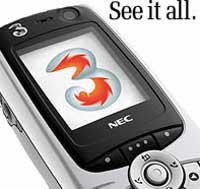 The end result is a predictable but unit-shifting fare of footie, ringtones, horoscopes, weather and the like.
The end result is a predictable but unit-shifting fare of footie, ringtones, horoscopes, weather and the like. Sky has for quite a long time been evaluating the best CoDEC for their High-Definition TV (HDTV) service. They currently deliver their content using an MPEG-2, which given the extra bandwidth that HD requires would make the demand on satellite bandwidth too high.
Sky has for quite a long time been evaluating the best CoDEC for their High-Definition TV (HDTV) service. They currently deliver their content using an MPEG-2, which given the extra bandwidth that HD requires would make the demand on satellite bandwidth too high. Skype has announced a new partnership with Broadreach Networks which is giving UK Skype users free Wi-Fi access to make free Skype calls in 350 Internet locations across the UK.
Skype has announced a new partnership with Broadreach Networks which is giving UK Skype users free Wi-Fi access to make free Skype calls in 350 Internet locations across the UK. For Skype to be really useful for end-users, you have to be able to use it when you are out, and in more and more places. Combination of WiFi and Skype is a good synergy; make free wireless calls.”
For Skype to be really useful for end-users, you have to be able to use it when you are out, and in more and more places. Combination of WiFi and Skype is a good synergy; make free wireless calls.”